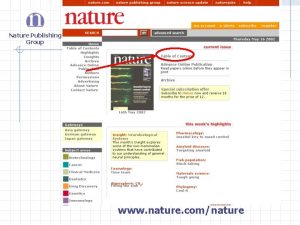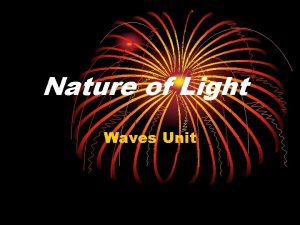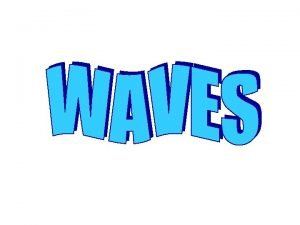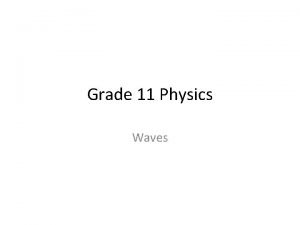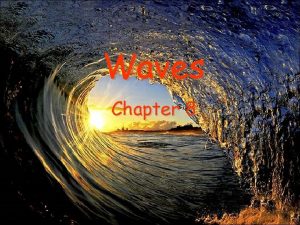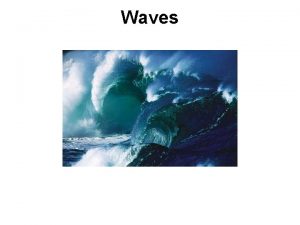Waves 9 1 The Nature of Waves Waves














































- Slides: 46

Waves

9 -1 – The Nature of Waves • Waves Defined • Wave – • Ex: • Waves and Energy • Waves transfer energy, not matter

9 -1 – The Nature of Waves • A medium is a substance or material which carries the wave. • Electromagnetic Waves are the exception, they do not need a medium to travel.

9 -1 – The Nature of Waves • Mechanical Waves • Transverse Waves • Ex: • Longitudinal Waves • Ex:

9 -2 – Wave Properties • • Parts of a Wave

9 -2 – Wave Properties • Wavelength –

9 -2 – Wave Properties • Wavelength and Frequency • Inverse relationship

9 -2 – Wave Properties • Calculating Frequency • Frequency (Hz) = # of waves time (s) • Calculating Wavelength • Wavelength= 1/ frequency

9 -2 – Wave Properties • Calculating Frequency Calculate the frequency of this wave if it occurs over 2. 5 seconds.

9 -2 – Wave Properties • Calculating Frequency • A ruby-throated hummingbird beats its wings at a rate of about 70 wing beats per second. What is the frequency in Hertz of the sound wave?

9 -2 – Wave Properties • Calculating Frequency • Joe counts waves as they pass a lighthouse. If he counts 15 waves occurring over 4. 1 seconds, what is the frequency of the waves?

9 -2 – Wave Properties • Calculating Frequency • A buoy bobs up and down in the ocean. The waves have a wavelength of 2. 5 m, and they pass the buoy at a speed of 4. 0 m/s. What is the frequency of the waves?

9 -2 – Wave Properties • Calculating Speed • V = f • Velocity (m/s) = frequency (Hz) x wavelength (m)

9 -2 – Wave Properties • • • Calculating Speed A wave traveling in the water has a frequency of 250 Hz and a wavelength of 6. 0 m. What is the speed of the wave?

9 -2 – Wave Properties • Calculating Speed • The lowest pitch that the average human can hear has a frequency of • 20. 0 Hz. If sound with this frequency travels through air with a speed • of 331 m/s, what is its wavelength?

9 -2 – Wave Properties • Calculating Speed • A ship anchored at sea is rocked by waves that have crests 14 m apart. • The waves travel at 7. 0 m/s. How often do the wave crests reach the • ship?

9 -2 – Wave Properties • Ocean Waves are a transverse and longitudinal wave in one • Acts as both:

9 -2 – Wave Properties • Amplitude – • Tells about the energy of a wave

Ch 10 - Sound • What causes sound? • Vibrations, Create longitudinal waves • Energy from wave transferred to your eardrum • Your brain interprets this as sound

Ch 10 - Sound • Frequency of sound wave determines pitch (high, low)

Ch 10 - Sound • Instruments create different pitches in different ways • Change length of instrument’s tube by opening holes (wind instruments) • Change length of vibrating string (guitar, violin)

Ch 10 - Sound • Speakers turn electrical energy into sound waves • Vibrating cone inside speaker produce sound waves

Ch 10 - Sound • Radio waves are used in radios. • AM radio waves are measured in kilohertz (k. Hz) • FM radio waves are measured in megahertz (MHz) • Cell phones operate in gigahertz (GHz)

Ch 10 - Sound • We cannot hear sound in outer space. • Sound waves need particles in a solid, liquid, or gas to vibrate • No air in outer space for sound waves to vibrate.

Ch 10 - Sound • Speed of Sound depends on • Wind conditions • Temperature • Humidity • How fast does sound travel? • 330 meters per second (dry air, 00 C) • Faster in liquids (4 x faster) • Even faster in solids (15 x faster)

Ch 10 - Sound • Frequency and pitch have a direct relationship • Amplitude and loudness have a direct relationship

Ch 10 - Sound • The Doppler Effect • Perceived change in wavelength, frequency, and pitch due to a moving object • No actual change in sound, just perceived change due to the object moving toward you, then away from you.

Ch 10 - Sound • Refraction of Sound • Bending of wave due to speeding up or slowing down • Change in Medium

Ch 10 - Sound • Reflection of Sound Waves(Sound waves bouncing) • Waves reflect at the same angle that the wave hits (law of reflection) • Echoes work on this principle. • Theaters and concert halls are designed to reduce echoes.

Ch 10 - Sound • Applications of Reflected Waves • Sonar “sound navigation ranging” • Sonography • Ultrasound • Echolocation

Ch 10 - Sound Waves Electromagnetic Waves Cannot travel in a vacuum Particles compress and relax as the wave travels through Are longitudinal waves that transmit energy Produce vibrations which can be sensed and some heard Have crests, troughs, and a resting equillibrium Reflect, refract, and are absorbed Can travel in a vacuum Have a dual quality (particles and energy) Are transverse waves that transmit energy Only portion of electromagnetic waves are visible

Electromagnetic Spectrum- Visible • Electromagnetic Waves • Are part magnetic field and part electric field • Have properties of both waves and particles • Can travel without a medium • All travel at the same speed (speed of light)

Electromagnetic Spectrum- Visible • Electromagnetic Spectrum • Organizes electromagnetic waves according to frequency • Also shows the wavelength of various waves • Remember relationship between frequency and wavelength • We can only see one small portion of the EM spectrum

Electromagnetic Spectrum- Visible

Electromagnetic Spectrum- Visible • Visible Spectrum • Filters allow certain colors to pass, block others

Electromagnetic Spectrum- Visible • Visible Spectrum • We see colors based on those absorbed and those reflected • Red car = Red light reflected • White car = all colors reflected • Black car = all colors absorbed

Electromagnetic Spectrum- Visible • Visible Spectrum • Opaque objects • Reflect the light • Cannot see through opaque items

Electromagnetic Spectrum- Visible • Visible Spectrum • Translucent objects • Reflect some light, transmits some light • Can somewhat see through translucent items

Electromagnetic Spectrum- Visible • Visible Spectrum • Transparent objects • Transmits light • Can see through transparent items

Electromagnetic Spectrum- Non. Visible • Rest of the Electromagnetic Spectrum (excluding visible light)

Electromagnetic Spectrum- Non. Visible • Radio Waves • Lowest-energy, lowest frequency, largest wavelength • Transmit radio, tv, and cellular signals • Sources: electric circuits

Electromagnetic Spectrum- Non. Visible • Microwave Waves • Lower-energy, lower frequency, larger wavelength • Used to heat food, used in radar guns • Sources: special vacuum tubes, like those in microwave ovens

Electromagnetic Spectrum- Non-Visible • Infrared Waves • Low-energy, low frequency, large wavelength • Heat emitted from warm objects, used in special cameras • Sources: anything that gives off heat

Electromagnetic Spectrum- Non-Visible • Ultraviolet (UV) Waves • high-energy, high frequency, small wavelength • Emitted from the sun, very hot objects, like sun lamps • Sources: special vacuum tubes, like those in microwave ovens

Electromagnetic Spectrum- Non-Visible • X-ray Waves • higher-energy, higher frequency, smaller wavelength • Emitted from x-ray machines, used to image people’s bones • Detected through high speed collisions between electrons

Electromagnetic Spectrum- Non-Visible • Gamma Ray Waves • highest-energy, highest frequency, smallest wavelength • Emitted from nuclear reactions • Sources: radioactive substances • Can be detected with a Geiger counter.
 Nature and nature's law lay hid in night meaning
Nature and nature's law lay hid in night meaning Determinace lidské psychiky
Determinace lidské psychiky The nature of waves chapter 10 section 1
The nature of waves chapter 10 section 1 Aimtoknow
Aimtoknow Is a seismic wave mechanical or electromagnetic
Is a seismic wave mechanical or electromagnetic The wave chapter 13
The wave chapter 13 Examples of mechanical and electromagnetic waves
Examples of mechanical and electromagnetic waves Light waves are transverse waves true or false
Light waves are transverse waves true or false Sound is a longitudinal wave
Sound is a longitudinal wave Mechanical and electromagnetic waves similarities
Mechanical and electromagnetic waves similarities Compare and contrast p waves and s waves using venn diagram
Compare and contrast p waves and s waves using venn diagram Mechanical wave and electromagnetic wave
Mechanical wave and electromagnetic wave Carbon dioxide temperature
Carbon dioxide temperature Surface waves and body waves
Surface waves and body waves Mechanical waves and electromagnetic waves
Mechanical waves and electromagnetic waves Similarities of mechanical and electromagnetic waves
Similarities of mechanical and electromagnetic waves Mechanical waves and electromagnetic waves similarities
Mechanical waves and electromagnetic waves similarities Parts of a longitudinal wave
Parts of a longitudinal wave Hổ sinh sản vào mùa nào
Hổ sinh sản vào mùa nào Diễn thế sinh thái là
Diễn thế sinh thái là Vẽ hình chiếu vuông góc của vật thể sau
Vẽ hình chiếu vuông góc của vật thể sau 101012 bằng
101012 bằng Công thức tiính động năng
Công thức tiính động năng Tỉ lệ cơ thể trẻ em
Tỉ lệ cơ thể trẻ em Thế nào là mạng điện lắp đặt kiểu nổi
Thế nào là mạng điện lắp đặt kiểu nổi Lời thề hippocrates
Lời thề hippocrates Vẽ hình chiếu đứng bằng cạnh của vật thể
Vẽ hình chiếu đứng bằng cạnh của vật thể đại từ thay thế
đại từ thay thế Quá trình desamine hóa có thể tạo ra
Quá trình desamine hóa có thể tạo ra Các môn thể thao bắt đầu bằng từ đua
Các môn thể thao bắt đầu bằng từ đua Hình ảnh bộ gõ cơ thể búng tay
Hình ảnh bộ gõ cơ thể búng tay Khi nào hổ con có thể sống độc lập
Khi nào hổ con có thể sống độc lập Các loại đột biến cấu trúc nhiễm sắc thể
Các loại đột biến cấu trúc nhiễm sắc thể Nguyên nhân của sự mỏi cơ sinh 8
Nguyên nhân của sự mỏi cơ sinh 8 Phản ứng thế ankan
Phản ứng thế ankan Trời xanh đây là của chúng ta thể thơ
Trời xanh đây là của chúng ta thể thơ Voi kéo gỗ như thế nào
Voi kéo gỗ như thế nào Thiếu nhi thế giới liên hoan
Thiếu nhi thế giới liên hoan điện thế nghỉ
điện thế nghỉ Fecboak
Fecboak Một số thể thơ truyền thống
Một số thể thơ truyền thống Thế nào là hệ số cao nhất
Thế nào là hệ số cao nhất Lp html
Lp html Hệ hô hấp
Hệ hô hấp Số nguyên là gì
Số nguyên là gì đặc điểm cơ thể của người tối cổ
đặc điểm cơ thể của người tối cổ Các châu lục và đại dương trên thế giới
Các châu lục và đại dương trên thế giới






























































